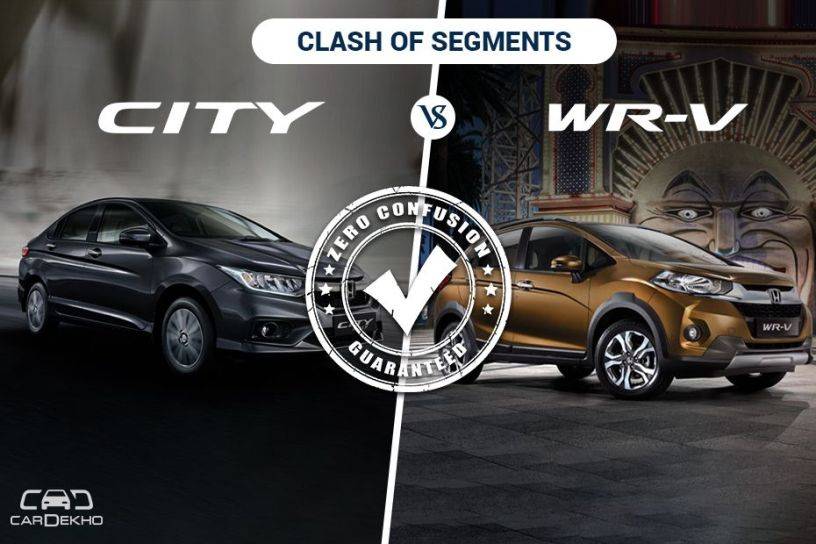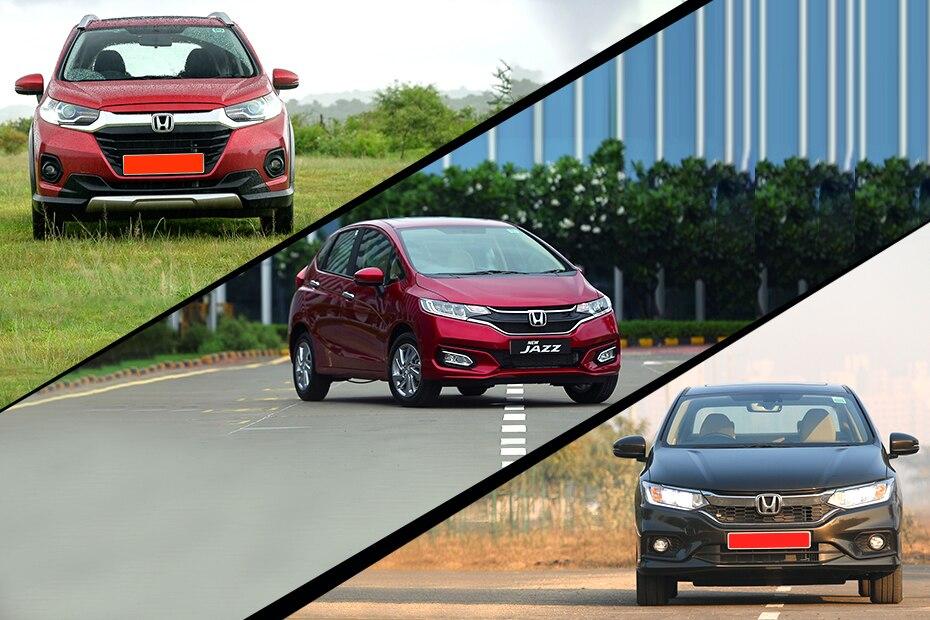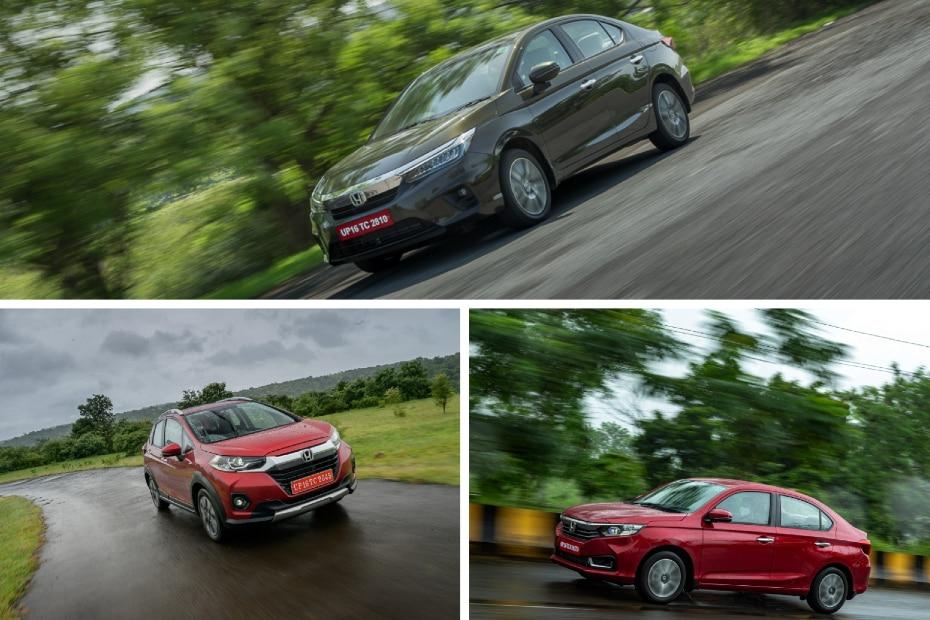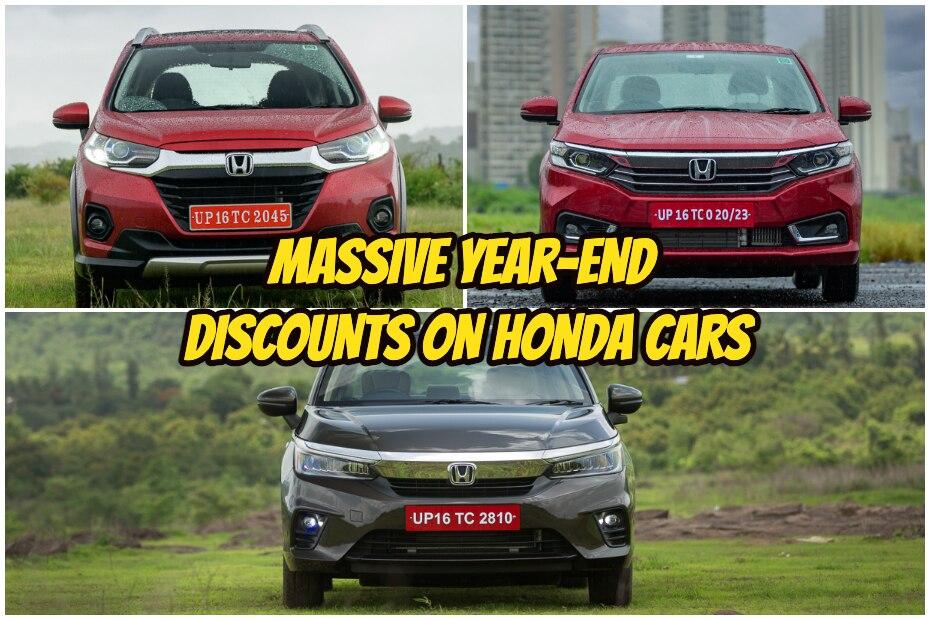Clash Of Segments: Honda City vs WRV-Which One To Buy?
Modified On Apr 07, 2018 09:03 AM By CarDekho
- Write a comment
Let’s see how Honda’s best-selling SUV stacks up against its highest selling sedan

Everyone knows the Honda City and WR-V are not natural rivals. The former is a conventional three-box sedan while the latter is essentially a jacked-up hatchback with some cosmetic enhancements to make it look rugged. What’s common is that they are both Hondas and share their diesel engine, but there’s only one petrol variant of each of these cars that’s priced so close that some buyers might want to compare the two.
And that’s what we’ve just done. But before we compare the closely priced variants, here are some of the basic differences between these two cars:
| Honda City |
Honda WR-V |
| A conventional sedan: The Honda City is a traditional three-box sedan. It has a 510-litre boot and can seat 5 people. It's also the longer car of the two so bear that in mind if you often drive to places where parking spaces are tight |
Jacked-up hatchback: The concept of turning a hatchback into a high-heeled utility vehicle is new but not alien. The WR-V has a lot in common with the Honda Jazz but it rides high, has a longer wheelbase and gets plastic cladding on the outside. All these additions make it more utilitarian than the Jazz, which is one of the more practical hatchbacks in its segment when it comes to utilisation of space inside the cabin. The WR-V has a smaller boot (363 litres) than the City but you can fold its seats completely down to carry extra luggage. It’s also not as long as the City and is, therefore, easier to move around in the city. |
| Bigger, more powerful yet fuel efficient petrol engine: The Honda City’s 1.5-litre i-VTEC petrol enginemakes more power than the WR-V’s 1.2-litre unit. Surprisingly, the City is still almost as fuel efficient as the WR-V, with the claimed mileage figure almost at par with the SUV. This could be because the City weighs less than the WR-V. Being a sedan, the City might have an aerodynamic edge over the WR-V as well. |
Small 1.2-litre engine feels underpowered: The WR-V gets the same 1.2-litre i-VTEC engine as the Jazz and makes 90PS on paper. This engine feels a little underpowered on the WR-V. The engine is, however, refined and should do the job for city runabouts. |
| Balanced ride and handling package: The City’s ride is on the stiffer side if you compare it with the WR-V but that adds to its high-speed stability. However, expect small bumps and potholes to be felt inside the cabin. |
Soft ride is good at slow speeds: The WR-V’s suspension is set up on the softer side and that makes it soak road uncertainties pretty well, especially at slow speeds. However, there is a downside to it: at high speeds the ride gets bouncy and the side-to-side motions are also felt inside the cabin. This can be tiresome on long journeys. |

Prices:
| Honda City |
Honda WR-V |
|||
| Petrol |
Diesel |
Petrol |
Diesel |
|
| S |
Rs 8.71 lakh |
NA |
Rs 7.78 lakh |
Rs 8.81 lakh |
| SV |
Rs 9.74 lakh |
Rs 10.99 lakh |
NA |
NA |
| V |
Rs 9.99 lakh |
Rs 11.78 lakh |
NA |
NA |
| V CVT |
Rs 11.72 lakh |
NA |
NA |
NA |
| VX |
Rs 11.83 lakh |
Rs 13.08 lakh |
Rs 9.00 lakh |
Rs 9.99 lakh |
| VX CVT |
Rs 13.02 lakh |
NA |
NA |
NA |
| ZX |
NA |
Rs 13.77 lakh |
NA |
NA |
| ZX CVT |
Rs 13.70 lakh |
NA |
NA |
NA |
Variants:
The Honda WR-V’s top VX variant with the petrol engine is priced at Rs 9 lakh. We’ve compared this variant with the base S variant of the petrol-powered Honda City, which is priced at Rs 8.71 lakh. While the WR-V VX is also available with a diesel engine, priced at Rs 9.99 lakh (ex-showroom Delhi), Honda doesn’t offer the base S variant of the City with the diesel engine. As a result, the price difference between the most affordable diesel Honda City SV and the most expensive diesel WR-V VX is Rs 1 lakh.
Honda WR-V VX vs Honda City S
Features:

Being the top-spec model, the WR-V VX is clearly more feature-loaded than the City S. Where the WR-V is packed with comfort features such as automatic climate control, rear parking camera with sensors, power-foldable ORVMs and telescopic-adjustable steering wheel, the City S ticks just the basics like an audio system, manual AC, power windows, tilt-adjustable steering and electrically adjustable ORVMs. However, both cars are equally equipped when it comes to safety and get dual front airbags and ABS with EBD. The City gets ISOFIX child seat anchors as well. Features like sunroof, touchscreen infotainment system, chrome door handles and alloy wheels add to the feel-good factor of the WR-V. All these are missing in the base variant of the City.
Why buy the City?

-
Boot space: The City’s 510 litres of boot can any day hold more luggage than the WR-V, even with 5 people on board. So if that’s a basic requirement for you, go for the City.
-
More powerful engine: The City’s 1.5-litre petrol engine makes 29PS more than the WR-V’s and is still almost as fuel efficient as the WR-V on paper. If you want a more fun-to-drive car, then opt for the City, especially the petrol. The City diesel is also an efficient highway cruiser but is better suited for those with a relaxed driving style
-
Resale value: The City nameplate enjoys a good resale value in India. While the WR-V is a relatively new product and can’t be directly compared on this front, the City’s past record does give it an advantage.
-
Safety: If you have kids, the City is a safer choice as it comes with ISOFIX child seat anchors that will allow you to install child seats on the rear seats.
Related: Hyundai Verna vs Honda City: Comparison Review
Why buy the WR-V?

-
Features: The WR-V is loaded to the gills. Features like sunroof, tilt- and telescopic-adjustable steering, alloy wheels, automatic climate control, parking camera and alloy wheels not only make it look the part but also add to the convenience.
-
Size: The WR-V is smaller than the City, and if parking space is an issue at your residence or office the WR-V will be easier to move about in.
-
High ground clearance: Our roads are infamous for their potholes and Honda’s sedans have traditionally not fared well against them, scraping their underbelly on many occasions. The WR-V, then, with its 188mm ground clearance, will let you own the Honda badge without worrying about low ground clearance.
Related: Honda WR-V vs Maruti Vitara Brezza: Comparison Review
Before we end this comparison, here’s a look at the specifications of both these cars
Dimensions
| Honda City |
Honda WR-V |
|
| Length |
4440mm |
3999mm |
| Width |
1695mm |
1734mm |
| Height |
1495mm |
1601mm |
| Wheelbase |
2600mm |
2555mm |
| Ground Clearance |
165mm |
188mm |
| Boot Space |
510 litres |
363 litres |
| Kerb Weight |
Upto 1175kg |
Upto 1204kg |
Engine
Petrol:
| Honda City |
Honda WR-V |
|
| Displacement |
1.5-Litre i-VTEC |
1.2-litre i-VTEC |
| Power |
119PS @ 6,600rpm |
90PS @ 6,000rpm |
| Torque |
145Nm @ 4,600rpm |
110Nm @ 4,800rpm |
| Transmission |
5MT/CVT |
5MT |
| Fuel Economy |
17.4kmpl/18kmpl |
17.5kmpl |
Diesel
| Honda WR-V |
Honda City |
|
| Displacement |
1.5-litre i-DTEC |
1.5-litre i-DTEC |
| Power |
100PS @ 3,600rpm |
100PS @ 3,600rpm |
| Torque |
200Nm @ 1,750rpm |
200Nm @ 1,750rpm |
| Transmission |
6 MT |
6 MT |
| Fuel Economy |
25.5kmpl |
25.6kmpl (SV,V), 25.1kmpl (VX,ZX) |
Also Read: Honda Considering New Amaze-Based Sub-compact SUV For India? Top Boss Drops A Hint
Read More on : Honda City diesel















